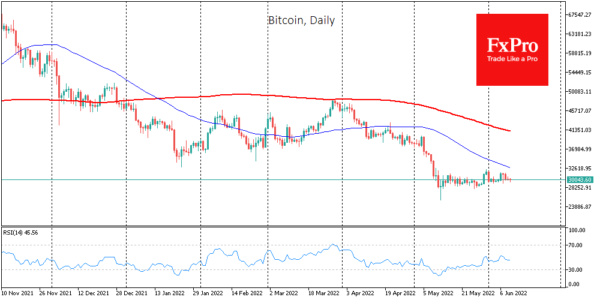Bitcoin was down 0.3% on Thursday, continuing to hover around $30K. This mild decline was a bonus of last month’s loss of correlation between the cryptocurrency and stock markets.
Ethereum lost 0.4%, settling near $1800. Other top-10 altcoins showed mixed dynamics, ranging from a 2.5% decline (Cardano) to a 3.6% rise (Solana).
Financial market veteran Peter Brandt believes Ethereum is in a downward triangle and could fall to $1268 within a month.
The total capitalisation of the crypto market, according to CoinMarketCap, fell 0.2% overnight to $1.24 trillion. The cryptocurrency fear and greed index were up 2 points to 13 by Friday and remains in “extreme fear” mode.
Bitcoin has crossed the $30K mark almost daily over the past month, with no significant preponderance of buyers or sellers to form a clear trend.
Generally, the correlation gap between cryptocurrencies and stock markets is long-term good news as it attracts the attention of professional investors. Weakness in equity and bond markets, sagging gold and the murky outlook for the real estate market are turning their eyes to cryptocurrencies as another tool in a diversified portfolio.
CNBC’s Mad Money host Jim Cramer has changed his mind about investing in cryptocurrencies, calling BTC and ETH the best long-term investments. However, they should not account for more than 5% of a portfolio.
PwC, an audit firm, reported that most hedge funds invest less than 1% of their assets in cryptocurrencies because of regulatory uncertainty in the industry.
According to a Deloitte survey, 75% of US retailers will implement support for cryptocurrency payments within two years.
USDT, the world’s most prominent staple by market capitalisation, will be available on the Tezos blockchain powered by the Proof-of-Stake consensus mechanism. The USDT ecosystem is now open on 12 networks, including Ethereum, Solana, Polygon, Tron and Algorand.



 Signal2forex.com - Best Forex robots and signals
Signal2forex.com - Best Forex robots and signals




